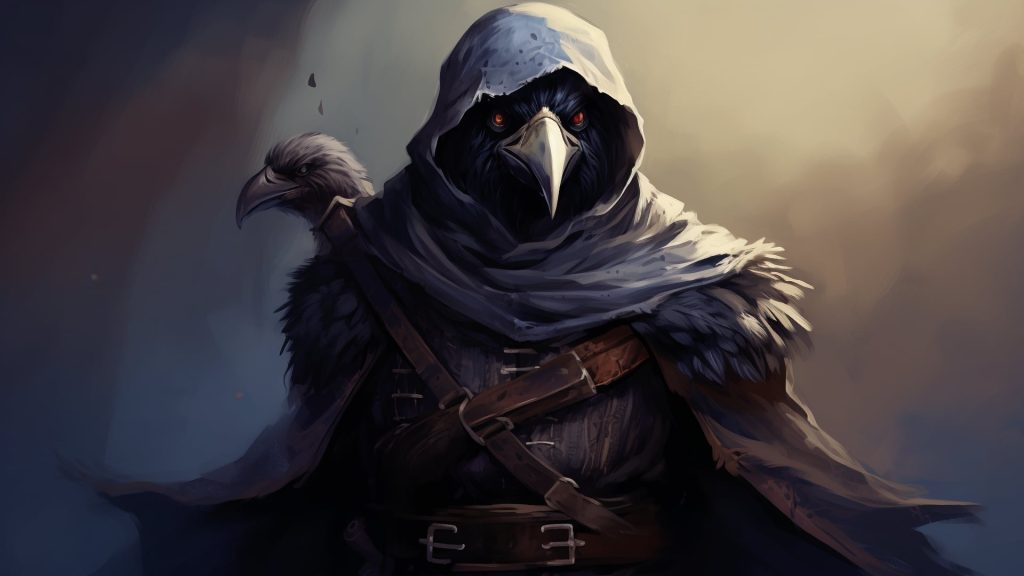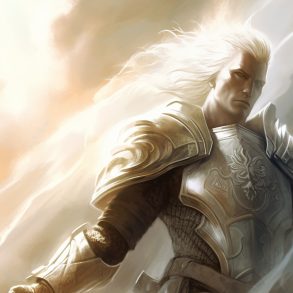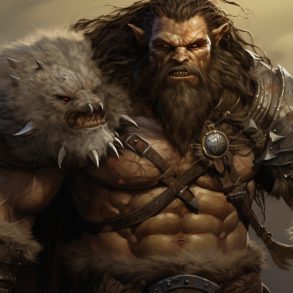You’ve made it up the ranks and you’re finally ready for some real work, maybe you’re interested in that tomb raiding job, or taking care of the tyrannical lord one fiefdom over. Whatever your interest in one of the most iconic classes of Dungeons & Dragons, at the Dice Cove, we have your back.
In this Rogue DnD 5E guide, we’ll sneak you through all the options for the Rogue, as well as supportive choices you can make to build your character to achieve what you want. Whilst reading through this guide, you may find our articles on DnD terms and list of DnD books (and their common abbreviations) helpful.
This Rouge DnD 5E guide will evaluate each option for the Rogue on a scale of 1-5– this is a rating of the abilities’ potency and overall usefulness, primarily focusing on combat where appropriate. That said, I will still evaluate everything. This can aid you to weigh any choices you might be considering at a glance, helping you know what to expect and make changes accordingly if desired. The rating scheme is:
1 – Usually a bad choice, to be avoided
2 – Below average, this can apply to powerful but very niche abilities
3 – Average to Good, you won’t go wrong with it
4 – Very good
5 – Amazing, a must-have if there is such a thing
Be sure to check our other DnD 5E class guides: Artificer 5E guide, Barbarian 5E guide, Fighter 5E guide, Monk 5E guide, Paladin 5E guide, Ranger 5E guide, Sorcerer 5E guide, and Warlock 5E guide.
Changelog
Version 1.3
- Added Mordenkainen Presents: Monsters of the Multiverse races
Version 1.2
- Added Owlin race and Strixhaven feats
Version 1.1
- Added races: Harengon, Fairy, and FToD Dragonborn
- Added feats: FToD Gift of… feats
Disclaimer
This rating system exists to best help you understand the effectiveness of all the options available to the class for you to build and enjoy your character. Remember though, your fun comes first; it’s actually very difficult to build a character that is entirely bad in DnD 5E, so if you have a concept that doesn’t rate highly, you might still have fun playing it. This is a guide, not a contract written by Asmodeus. Let it advise you and not force you away from your own ideas.
It’s recommended to have your book/PDF/DnD Beyond page open to reference and follow along with the guide.
Table of Contents
Rogue DnD 5E Class Abilities Guide

Hit Dice 3 – A d8 isn’t very good for a martial, but you at least have the option of being a ranged or skirmishing combatant.
Rogue DnD 5E Proficiencies Guide

Armor 3 – Light Armor isn’t so bad for a Rogue, as you’ll be wanting to max out your Dex as soon as possible anyway. The Rogue primarily mitigates damage in ways other than high AC.
Weapons 4 – Since Rogues want finesse or ranged weapons this is almost as good as it gets, really. The only improvements would be access to the longbow and heavy crossbow.
Tools 4 – You only get one, but it’s the most useful one.
Saving Throws 4 – Dexterity saving throws are common from spells to traps, and every breath weapon in between so this proficiency will save you a lot of damage taken. Intelligence is very rare, though if it comes up it probably saved your brain from a nasty fate.
Skills 5 – Rogues get the most skills of any class in the game and can choose from a broad list. The standouts here are Perception and Stealth, with the only notable skill missing being Arcana.
Expertise 5 – Doubling your proficiency bonus with certain skills or your Thieves’ Tools makes you far more consistent in passing checks and able to achieve higher DCs. For certain builds like grapplers, this is an essential feature, and overall cements the Rogue’s place as one of the best skill monkeys in the game.
Sneak Attack 5 – The core of a Rogue’s damage output and referred to as Sneak for short, it places certain limitations on what weapons you can use, but in practice, you won’t miss out on anything from this. An important thing to note here is that Sneak Attack is once per turn, not once per round. This means that if you hit someone with a readied attack or an attack of opportunity, and you qualify, you can still get your sneak damage.
Thieves’ Cant 3 – As far as ribbons go this is very limited in use but can provide story hooks for your character and discreet communication between party members. When you’re getting this on top of Expertise and Sneak Attack it can’t be too good!
Cunning Action 5 – Another integral part of the Rogue’s core abilities, this allows you to skirmish to your heart’s content, Hide better than any other class, and makes the Rogue the fastest class by default by allowing them to at-will double Dash every turn. The only downside to this great ability is that it provides you with a lot of nice things to use your bonus action for, which can be problematic if you want to two weapon fight or use bonus action spells etc.
Ability Score Increase 5 – This isn’t normally included in our guides as they’re standard for most classes, however, the Rogue gets an additional ASI at 10th level. This is a higher level than a lot of folk play, but an additional ASI can really help with feat-heavy concepts in games where it applies.
Uncanny Dodge 4 – A fantastic defensive ability that allows a Rogue to hang out in melee despite only having a d8 hit die and average AC. The reasons this only gets a 4 are the lack of protection against enemies you can’t see and the diminishing returns in combat encounters where you may get hit multiple times a round instead of one big hit.
Evasion 5 – Dex saves are common and between this and your high Dex save bonus you’ll take no damage from Dex save-based hazards a lot of the time and even if you get unlucky you’ll only take half damage at most. The cherry on top is that this is a passive ability, you don’t even need to use your reaction!
Reliable Talent 5 – This ability makes it incredibly unlikely that you’ll fail any skill check you’re proficient in ever again. In some instances it can make your minimum result unreasonably high, for example at 11th level a Rogue with a +5 Dex and Expertise in Stealth would have a minimum Stealth check result of 23!
Blindsense 1 – You need to be very aware that this is not actually blindsight like a monster may have, you’ll be aware of anyone invisible that may try and hide but they’ll still benefit from being unseen against you.
Slippery Mind 4 – Wisdom saving throws are nasty to fail and become increasingly common the higher up in levels you go.
Elusive 4 – It isn’t glamorous, but it is a solid defense. This is only a 4 because advantage against you is pretty situational.
Stroke of Luck 4 – Once per rest you can turn a miss into a hit or give yourself a 20 on a skill check, that’s a pretty great ability for a class that focuses on single, big hits.
Rogue 5E Optional Class Features (TCoE) Guide

The Rogue only gets a single optional feature from Tasha’s, this is an additional ability and does not replace anything:
Steady Aim 3 – On-demand advantage is very nice for a Rogue, but the limitation of not moving at all on that turn is a steep cost. This makes the ability useless to skirmishing Rogues and only useful to ranged Rogues that are already in a favorable position, or rarer tanking Rogues already in melee.
Rogue 5E Stats Guide

Rogues, as covered in our Rouge DnD 5E guide are one of the easiest classes to make work with stats as they’re primarily Dex SAD, but it’s still important to understand how valuable each stat is to a Rogue before we get into the subclasses. It’s worth noting that because Rogues are mostly Dex SAD, they can afford better tertiary stats than other classes, be it for utility or roleplay.
Strength 2 – Even if you want to grapple you don’t need this as you can take Expertise in Athletics, you may want a 10 in this if only to not detract from your checks and give you a reasonable carrying capacity.
Dexterity 5 – The primary stat for the Rogue and so integral that you should try and max it as quickly as you can, or try to get it to at least 18 before you take a feat with an ASI.
Constitution 3 – The stat everyone wants, I’d recommend trying to go a little higher in Con if you can afford to, especially if you’re a melee Rogue to compensate for your d8 hit die. If you don’t want to invest too much in Con then try to put at least a 14 here.
Intelligence 2 – If you want to find loot and traps then Int is a stat you’ll want to consider for Investigation. If you’re an Arcane Trickster this goes up to a 4, but isn’t necessarily needed depending on spells chosen.
Wisdom 3 – At least a 14 would be nice for Wis, it’s not only useful for your Perception, but without proficiency in Wis saves until later in the game a positive modifier becomes more important for passing saves against nasty monster effects.
Charisma 3 – Primarily for face characters, it never hurts to have a decent Cha score, if you’re a Swashbuckler then this goes up to 4.
Roguish Archetypes (Subclasses) Guide

Your subclass can really influence the role and style of play for your Rogue, in some cases, it can also affect the value of certain stats so it’s important to think about which subclass you’ll choose at character creation:
Thief
The iconic thief style of Rogue is given some support here, this subclass is often regarded as one of the weakest Rogues. The value of the abilities here is somewhat DM-dependent and requires you to actively get use out of them. Once you get the hang of it there’s a surprising amount of potential here.
Fast Hands 3 – The cornerstone of the Thief, this is an ability that relies primarily on your creativity which is why this only gets a 3. With this, you can attempt to pickpocket an enemy or unlock a door to escape all mid-combat. The main power of this ability is with the Use an Object action, which will allow you to use items like a Healer’s Kit, Acid, Alchemist’s Fire, and oil. It’s important to note that if you use something like Acid you can make the attack as part of your bonus action and you include your Dex mod in the damage.
Second-Story Work 2 – Alongside Fast Hands this is pretty nice and lends a very Batman feel to the Thief, but it is a very situational ability.
Supreme Sneak 2 – Advantage on Stealth is nice, but slowing down to do so isn’t great, especially when you can already be exceptionally good at Stealth with your high Dex and Expertise.
Use Magic Device 2 -Potentially a very powerful ability, but very dependent on the DM. It’s worth noting that this allows a Thief to use spell scrolls, which can be extremely useful.
Thief’s Reflexes 5 – An extra turn on the first round of every combat is a fantastic ability, especially as it will allow at least two Sneak Attacks and two reactions on that turn. The Alert feat is highly recommended if you’re a high-level Thief.
Assassin
Another player-favorite concept is the deadly killer hidden in the shadows, waiting to strike at their target. Unfortunately, this subclass is highly dependent on the Surprise mechanic, which relies not only on Stealth but on your DM.
Bonus Proficiencies 2 – These can be of use but aren’t widely applicable, there are better tools/kits to be proficient in.
Assassinate 2 – The automatic critical hit is what everyone thinks of with this ability, and when it happens it’s great, but it won’t happen frequently. Getting advantage against creatures that haven’t taken a turn yet is nice and carries this feature, but is unreliable and pushes the Assassin to take Alert.
Infiltration Expertise 2 – As far as 9th level Rogue abilities go it isn’t a bad one and plays well into the theme of the subclass. This is only a 2 because it’s all that the Assassin gets at 9th and is very narrow in scope.
Imposter 1 – Is this useful? Potentially, very useful, but it’s been ten levels since this Assassin got better at actually killing things.
Death Strike 1 – Not only is this capstone reliant on surprise, but it’s also reliant on the enemy failing a Con saving throw, which is usually a strong save for monsters. The potential damage is excellent, but the chance of getting that damage is too vanishingly small.
Arcane Trickster
Incredibly versatile and a player favorite, this archetype allows you restricted access to Wizard spellcasting, specifically making you a third caster. Through certain spell choices, this subclass is competitive for the highest damage dealing Rogue, but you should be careful to ration your very limited spell slots appropriately. Recommended spells for this subclass include Disguise Self, Silent Image, Shield, Find Familiar, Invisibility, and Shadow Blade. For cantrips, Booming Blade is highly recommended for damage and an added control effect.
Spellcasting 4 – Adding spellcasting to a well-built class like the Rogue was always going to go well, this only gets a 4 due to the school restrictions and the extremely slow spell slot progression of being a three-quarter caster.
Mage Hand Legerdemain 5 – For what it is this ability is very nice, it takes a great cantrip and allows you to make it invisible and use it to perform your usual Rogue antics at a distance. Something you could try mid-combat is taking the items being carried or worn by your opponent with your bonus action. This is a useful and rather hilarious way of dealing with a magic item using foe.
Magical Ambush 3 – Tying in with your high Dex, potential Expertise, and ability to bonus action Hide this feature isn’t bad, far from it, but the problem is that generally your action is better spent using Sneak Attack, especially if you can successfully Hide. There could be times this comes in handy, however, such as casting Hold Person on a humanoid enemy.
Versatile Trickster 4 – Giving yourself advantage is very nice, the only downside here is the need to have Mage Hand summoned and near the creature you’re attacking. This feature may be less appealing to those that can use Steady Aim.
Spell Thief 2 – It certainly sounds cool, but this feature falls down at quite a few points: the enemy needs to be a spellcaster, it relies on your spell save DC, it relies on an enemy caster failing a save with their strong stat, and to get the full use of the feature it needs to be a fairly low-level spell for Tier 4 so you can actually cast it.
Mastermind
For those that have ambitions of running their own organization, or simply want a more support-focused Rogue. This subclass was originally published in the SCAG and was reprinted in XGtE. This is primarily a roleplay pick but can work well in a party where you have an ally with Sharpshooter or Great Weapon Master.
Master of Intrigue 3 – Not a great feature, but it goes a long way towards helping you build a more espionage-style Rogue, most useful in an intrigue-heavy game. I know, surprising right?
Master of Tactics 3 – Getting the Help action at range is very nice for your party, and can certainly help them land hits that can save the day. This ability only gets a 3 however because a single attack at advantage doesn’t age very well as martials get more attacks, it’s dependent on having more attack roll users in your party, and finally, you can’t Help yourself. Ironically the best character to make use of your Help is another Rogue!
Insightful Manipulator 1 – Incredibly niche in use, it could be useful if you can get a BBEG into a situation where you can judge what their weaker save might be, but it won’t take into account their proficiencies. Not a good feature.
Misdirection 2 -Thematically a really interesting ability, with the idea of using enemies as meat shields against their own allies, it could work like that with a lot of maneuvering. However to get real use out of this your best bet is to hide behind a willing ally. This can be beneficial if the ally has a high AC, or an effect like Armor of Agathys, though does not make for a good ability.
Soul of Deceit 1 – An overly situational ribbon ability masquerading as a capstone.
Swashbuckler
The best skirmisher of all the Rogue subclasses, the Swashbuckler places a higher value on Cha and can make excellent use of two-weapon fighting. This subclass is really primarily for melee characters, but you can still switch hit effectively when you need to. Like the Mastermind, this subclass was also reprinted in XGtE.
Fancy Footwork 5 – An excellent ability that allows you to hit and run, or retreat whilst still getting some potential damage in. Yes, it restricts you to melee, but if you wanted to play an archer Rogue this subclass wasn’t your first choice anyway.
Rakish Audacity 5 – Cha modifier added to your already nice initiative and a way to make Sneak Attack more reliable? After I Googled what rakish means, I do agree that’s very charming.
Panache 5 – This feature makes you a skirmishing tank, encouraging enemies to try and chase after you instead of attacking your party, to do this effectively you’ll likely have to use Cunning Action Dash to be able to do this unless you have other speed buffs or switch to ranged attacks. This gets a 5 because it relies on a skill contest, making it very reliable as long as you take Expertise in Persuasion, and gives you some out of combat utility with the charm effect on non-hostile creatures.
Elegant Maneuver 1 – Advantage on Acrobatics and Athletics checks can be nice for escaping grapples, or making use of shove and grapple combos. This is a bad ability because Rogues are a bad chassis for grapple builds (as they only have one attack) and it consumes your valuable bonus action. If this came alongside a more useful ability then it may be worth a 2.
Master Duelist 3 – This is a very good ability that helps you land that Sneak Attack damage, it only gets a 3 because you can only use it once per short or long rest.
Inquisitive
The Sherlock Holmes of the Rogue world, is good for roleplaying a detective and excels at getting Sneak Attack reliably in combat, melee, or ranged. The Inquisitive is encouraged to take Expertise in Insight and have a decent (14+) Wisdom score in order to get the most out of their main feature.
Ear for Deceit 3 – A somewhat reliable way to determine if someone is lying, without having to use magic. Very thematic and fairly useful as far as ribbons go.
Eye for Detail 1 – Only really useful when fighting enemies that you can’t see, that are also actively hiding from you. If that comes up somewhat frequently in your game then this ability becomes extremely valuable.
Insightful Fighting 4 – As long as you invest in your Insight modifier this is a very reliable way to get Sneak Attack, especially at later levels when Reliable Talent becomes available. This only gets a 4 because it relies on your bonus action and is best suited to encounters with fewer monsters.
Steady Eye 3 – The speed clause of this is mostly relevant for dungeoneering, this gets a 3 for likely giving you advantage on all Perception/Investigation checks, but some more utility or something more combat relevant would have been preferable.
Unerring Eye 1 – Not only is this a pretty niche use ability, but it relies on you already being suspicious of something trying to trick you and then doesn’t give you any specifics other than vaguely confirming your suspicions.
Eye for Weakness 5 – An extra 3d6 Sneak Attack damage against targets you can reliably use Sneak Attack against? Oh yes.
Scout
Rogue: Ranger edition, this subclass gives you a bit of a wilderness feel but focuses primarily on mobility. This archetype is best suited to a ranged Rogue rather than skirmishing, though the latter can work if you commit your bonus action to disengaging.
Skirmisher 2 – An okay defensive ability for keeping you at range, this gets a lower score because it requires your reaction, putting it in contention with Uncanny Dodge if you get hit, or just hoping they miss!
Survivalist 5 – Two skills that you double your proficiency in? A great feature to go with the wilderness theme, just be careful you don’t pick up Nature or Survival before 3rd level to get the most of it.
Superior Mobility 2 – A 10ft boost is really nice, but as the only ability at 9th level it feels lackluster, if there was a second ability this would be at least a 3.
Ambush Master 4 – A pretty solid ability, I don’t feel that benefiting from the advantage is reliable enough to rate as a 5 however.
Sudden Strike 5 – Two Sneak Attack eligible attacks in a turn, every turn? Even if it eats your bonus action, that’s too strong to not be a 5.
Phantom
You see dead people, and take their stuff, or to be precise their knowledge and experiences. This subclass shines as a skill monkey and is above average for a Rogue at handling multiple enemies. This is definitely an archetype that shines more at higher levels when it comes to combat.
Whispers of the Dead 5 – A tool or skill of your choice whenever you finish a rest? Excellent utility ability.
Wails from the Grave 2 – Being able to automatically damage another creature when you Sneak Attack someone is great, but the number of uses is just too few for only half your Sneak damage and it’s useless against solo big tough monsters like dragons, etc. This gets better at higher levels.
Tokens of the Departed 4 – This feature brings some Speak with Dead-ish utility which can be useful, but more importantly it allows you to use your Wail from the Grave feature a more meaningful amount. This only gets a 4 because it requires a reaction and freehand, no TWF for you, and a lot of its value is just propping up another feature.
Ghost Walk 5 – There’s a lot here and it’s all good, either in combat or exploration. One of the biggest strengths of this ability is its first free use, with subsequent uses only costing you a single soul trinket, whilst the form itself lasts a respectable 10 minutes.
Death’s Friend 4 – A pretty substantial damage bump and being able to start the day with a soul trinket are very nice, this would be a 5 if it introduced something new or gave just a little more, you can think of it more like a 4.5.
Soulknife
A psionic option for the Rogue, this archetype is very well rounded and competes for highest damage Rogue immediately from 3rd level. RAW you won’t be able to make opportunity attacks with your Psychic Blades, but this is easily remedied by holding a dagger and passing it between your hands if it becomes a concern.
Psionic Power 5 – The pool of Psionic Energy Dice you get is very generous, as you won’t be relying on them and typically won’t expend them often. Psi-Bolstered Knack is a fantastic ability to ensure you pass your skill checks, and Psychic Whispers is most of Rary’s Telepathic Bond, a 5th level spell.
Psychic Blades 5 – This ability makes you a seamless switch hitter, with a large damage boost and the benefits of never being unarmed or slowed down by resistance to non-magical bludgeoning, piercing, and slashing? Outstanding ability. This can also benefit from the Thrown Weapon Fighting Style, adding damage to each attack.
Soul Blades 5 – A bonus action teleport ability and an accuracy boost that only uses a Psionic Energy Dice if it turns a miss into a hit? Nothing but sweet psionic gravy.
Psychic Veil 4 – A better version of Invisibility you can use for free once a day and more if you need it. This would be a 5 if it was more on par with Greater Invisibility but is still really nice.
Rend Mind 5 – This is a little like Stunning Strike for a Monk, but potentially lasts a minute once it’s in place, at 17th level you’ll have plenty of Psionic Energy Dice to make use of this ability.
Rogue DnD 5E Race Choices Guide

Races are good places to pick up abilities for certain character concepts, so if you’re thinking about playing a certain Rogue build but that race isn’t rated well here, it doesn’t mean your particular combination wouldn’t work or be fun to play. Like I said previously, it’s actually pretty difficult to make a truly bad character in 5e.
Here are some examples of strong race choices for a Rogue:
High Elf 5 – Darkvision, a Dex bump, Fey Ancestry, and Trance make a solid package for a Rogue. Getting a cantrip can be very useful, especially if you choose one like Booming Blade. The longbow is a nice upgrade for ranged Rogues.
es online and will help protect you in the instances where Uncanny Dodge doesn’t apply.
Half-Elf 4 – Half-elves are good at being pretty much anything, the stats are great for a Swashbuckler or face Rogue, with the two floating +1s giving you the physical stats you need. Skill Versatility, Darkvision, and Fey Ancestry aren’t flashy abilities, but solid passive benefits which suit any Rogue.
Lightfoot Halfling 5 – Big Dex bump, advantage against a common monster imposed condition, enhanced mobility on the battlefield, and extremely unlikely to roll a 1 on anything you do with a d20? Some stereotypes hold true, Hobbits halflings make for excellent thieves Rogues. Face and Swashbuckler Rogues will like the Cha, but all Rogues should appreciate being able to Hide behind your own allies, or even enemies!
Rogue DnD 5E Feats Guide

Feats, as described in this Rouge DnD 5E guide, can be a great way to enhance the potency and versatility of a Rogue, and with their additional ASI and relative SADness, they can afford a feat… or four! If you’ve started with an odd Dex, or don’t mind waiting a bit longer to max it out, then half feats which provide a Dex bump are great options and will be reflected in their rating. It’s worth keeping in mind the Rogue is primarily a martial which must use ranged or finesse weapons, and that is the lens through which these feats will be evaluated.
Here are some examples of strong feat choices for a Rogue:
Defensive Duelist 5 – A limitless reaction to boost your AC against an attack? You’re likely holding a finesse weapon already, why not! This should be chosen after maxing out your Dex.
Mobile 5 – Very good feat for melee Rogues, allowing all subclasses to effectively skirmish and ranged builds to stay out of reach easier.
Sentinel 4 – Using your reaction to attacks can lead to a huge amount of damage because of Sneak Attack, being able to attack as a reaction more reliably whilst preventing movement is great for melee Rogues.
Fighting Initiate 5 – An excellent feat, there are many Fighting Styles a Rogue can benefit from, including; Archery, Defense and, Dueling.
Piercer 5 – This one is a bit boring but solid, you get to progress your Dexterity and raise your average damage. Note, the reroll will work with your Sneak Attack dice, and who doesn’t want bigger crits?
Rogue DnD 5E Multiclassing Guide

In this section of our Rouge 5E guide, we’ll review each class in terms of how good of a multiclass option they are for a Rogue, mentioning how many levels and what subclass (if any) would work best. The ratings take multiclassing prerequisites into consideration; if a multiclass will require you to have a 13 in a stat other than Dex, it will likely receive a lower score unless the stat is one you would already have at 13 or higher, for example, Charisma for a Swashbuckler/face or Wisdom for anyone wanting good Perception.
General multiclass tips for the Rogue:
- You may want to wait until after 5th Rogue level, this will ensure you have your first ASI, Uncanny Dodge and a solid base of 3d6 Sneak Attack damage to build on with your multiclass.
- You need to use a finesse or ranged weapon, however you can still use your Str modifier if you want with finesse weapons. This means you can certainly build around Strength as your primary score and then use a class like Barbarian, just don’t start thinking of using GWM.
- The Rogue can benefit a great deal from Fighting Styles and additional opportunities to land Sneak Attack, so you may see some bias towards other martials for those reasons.
- Evaluate what type of Rogue you want to be, this will clarify what abilities or spells you’re hunting for in a multiclass, then review the feat section before committing to a multiclass.
- If a class has a reliance on bonus actions then it will be rated a little more poorly, due to the clash with Cunning Action. This is similar with reactions due to Uncanny Dodge and the prospect of reaction attacks.
Artificer 3 – Now this will require Int which is less than ideal, but you’ll get in return proficiency in medium armor, shields, and a couple of tools. The round up spell casting formula works well for adding to an Arcane Trickster, and all Rogues could benefit from the diverse selection of spells on the Artificer list. If you go two levels in then giving yourself a Bag of Holding and a magical weapon are nice perks, if you take three levels then the Armorer subclass is great for Rogues, specifically the Infiltrator armor version.
Barbarian 2 – Believe it or not, this multiclass can work very well if you’re using Strength as your attacking stat and go preferably five levels deep. You’ll get access to medium armor and shields, but more importantly, you’ll gain Rage. One of the benefits of Rage is adding more damage to an offhand strike, I would generally recommend either a dual-wielding or rapier and shield build with Barbarian. For subclass it really depends on what you want, Bear totem will give you the most resilience, whilst Zealot will give you some damage to compensate for the lost Sneak attack dice. It’s important to realize you don’t need to use Rage in every combat, you’ll run out very quickly if you attempt this. Avoid this if you’re a traditional Dex-based Rogue.
Bard 2 – This is a fantastic multiclass from a skill point of view, Jack of All Trades is a boost to the few skills you aren’t proficient in (and your initiative), whilst there’s opportunity for more Expertise. However I wouldn’t recommend dipping Bard on a Rogue, vice versa would be best, this is because a Bard really needs a high Cha modifier in order to get the most of their abilities, and maxing both Dex and Cha would be expensive. For subclasses the College of Swords is a great pick for a melee Rogue, offering a choice of Fighting Style, some Flourishes, and a great speed boost for Swashbucklers.
Cleric 3 – The great thing about multiclassing into Cleric is that 13 Wis or higher is already desirable, and the choice of subclass at 1st level makes them extremely front-loaded. I would only dip 1-2 levels into Cleric, the second level only if you want a specific Channel Divinity option. For choice of a subclass, you should decide whether or not access to heavy armor is something you want, for most Rogues staying with just using studded leather and a shield would be better. Stand-out subclass choices to dip are Life if you are looking to add a little healing to your repertoire, Forge if you want to make your own +1 item, or Twilight if you are interested in an initiative boost.
Druid 2 – This is a harder class to dip than Cleric purely because the goodies really start at the second level of Druid, which I advise you to take if you are dipping here at all. Wild Shape is a great scouting and utility ability, the Circle you choose is a little tricky as most depend heavily on your Druid level for scaling. The Circle of the Shepherd’s aura ability can be a nice boost to the party’s resilience or enable your own Sneak Attack, whilst the Circle of Stars’ adds the option of bonus action blasting, suddenly not Sneak eligible, or a surprising amount of healing.
Fighter 5 – You qualify for this multiclass by default and the early levels are extremely rewarding, what’s not to love? The Fighter can inject some valuable resources into the Rogue chassis, whilst also allowing access to shields and a Fighting Style that best suits your character. Battle Master is a popular option, the maneuvers can enable Sneak Attack, add damage, or provide support. The Samurai can allow you to give yourself advantage and temp hp three times a day, whilst the Psi Warrior can give you a balance of bonus damage and damage reduction. I would multiclass no further than six levels of Fighter and be wary that just taking one more level is a very easy trap to fall into.
Monk 1 – There’s no real temptation in the Monk class for a dip on a Rogue, you would need at least a 16 in Wisdom for Unarmored Defense to be worth it and if you want a bonus action attack you would be better off grabbing TWF from another martial. One Ki issue at hand here is just that, you won’t have enough Ki to do anything meaningful with. If you do go far enough in for a subclass the Kensei tradition is recommended for at-will abilities and giving access to the longbow.
Paladin 1 – With two prerequisite stats and a mostly dead first level this is not a good multiclass dip for most Rogues. If you do dip then at least two levels are required and you should choose either Defense, Dueling, or Blessed Warrior as your Fighting Style. Stand-out subclasses include the Oath of Vengeance for the Sneak enabling Vow of Enmity and the Oath of Conquest for Guided Strike.
Ranger 3 – You’re likely to already meet the Ranger prerequisites which is nice, taking the optional rules from Tasha’s is generally advised if possible. Hunter’s Mark won’t be much of a damage boost for you, so you’re better off taking the Two-Weapon Fighting Style for an additional attack and using your spell slots for Cure Wounds and utility spells like Longstrider. For subclasses, Hunter and Gloomstalker stand out, with the latter being preferred for the initiative boost, additional attack, and speed boost on the first round of every combat. This would pair well with all Rogues, but particularly the Assassin.
Sorcerer 4 – Sorcerer is a great dip class for a Rogue as, like a Cleric, they gain their subclass at 1st level, giving you the most bang for your gold piece. Charisma as a prerequisite isn’t bad, particularly for face and Swashbuckler Rogues, but I would recommend choosing spells that don’t require your spellcasting modifier such as Mage Hand, Booming Blade, Shield, and Absorb Elements. For subclasses, I would recommend Draconic for the permanent Mage Armor equivalent unless you already have magic armor, or the Divine Soul for Favored by the Gods and access to either Healing Word or Cure Wounds. One level of Sorcerer is enough unless you specifically want more spellcasting.
Warlock 4 – In some ways Warlock is better than Sorcerer as a Rogue dip, but without native access to Shield, it doesn’t warrant a 5. The strength of the Warlock is the mixture of patron, short rest spell slots, invocations, and pacts. I would recommend a 3 to 4 level dip if you can afford it, this would net you two short rest 2nd level slots (invisibility is highly recommended), two invocations (Devil’s Sight and Fiendish Vigor are good choices), as well as your pact and patron features. Recommended patrons are the Celestial for access to a surprising amount of healing and more cantrips, Hexblade for the Shield spell and armor proficiencies, or the Genie for Bottled Respite and the extra damage from Genie’s Wrath. For your pact, if you take three levels, combining Pact of the Blade with Improved Pact Weapon is great if you haven’t come across a magic weapon, or combining Pact of the Chain with Voice of the Chain Master gives a great degree of scouting and utility.
Wizard 3 – This is potentially a very useful dip, particularly for Arcane Tricksters who want some Intelligence anyway and would value the extra spell slots. At least two levels to get a subclass is recommended, with the best choices being Divination for Portent, and War Wizard for the initiative boost, and Arcane Deflection. Recommended spells are Find Familiar, Absorb Elements, Shield, and whatever ritual spells you find interesting. You won’t have the spells slots to cast many leveled spells, but there’s a large number of 1st level ritual spells like Detect Magic and Alarm which could be very useful to a Rogue.
Hopefully, our Rouge DnD 5E guide has helped you case the best marks for your next Rogue character, and you’re looking forward to stealing victory, and a few gold pieces, from the jaws of evil. If you want a closer look into a feat you’re considering for your new Rogue, check out our Feat Spotlight. Good luck out there, adventurers, and remember, if you can’t pick that lock, there’s always the strategic use of a crowbar.






